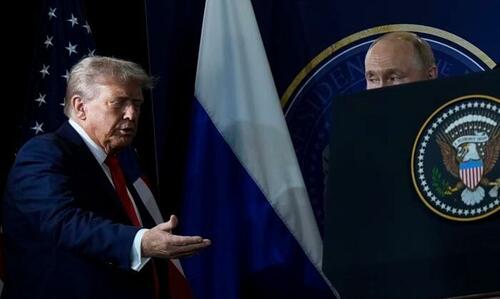Exxon Held Secret Talks To Resume Work In Russia
Once upon a time, the braindead puppet in the White House also known as Joe Biden exclaimed that Exxon made “more money than god” and while the former president was chronically wrong about everything, he may have been on to something here (even if the market to this day refuses to give Exxon the proper credit or PE multiple to go with its divine moneymaking skills). And there is a simple reason why while others struggle, Exxon prints money: the company isn’t afraid to go completely against the grain of conventional wisdom.

After huddling with President Trump in Alaska, President Vladimir Putin told reporters Russia and the U.S. could do more business together—for example, between their Pacific coastlines. “We look forward to dealing,” Trump replied.
What the two leaders didn’t say is that behind closed doors, their countries’ biggest energy companies had already sketched out a road map to going back into business, pumping oil-and-gas fields off Russia’s far-east coast.
As the FT and WSJ report, in secret (well, not so secret) talks with Russia’s biggest state energy company this year, a Exxon Mobil executives discussed returning to the massive Sakhalin project if the two governments gave the green light as part of a Ukraine peace process.
Such was the sensitivity that only a handful of people at Exxon knew the talks had taken place. One of the U.S. oil major’s top executives, Senior Vice President Neil Chapman, led the talks on the Exxon side.

Under the Biden and Trump administrations, Exxon and other companies have had U.S. permission and licenses from the Treasury Department to hold talks about stranded assets with Russian counterparts, a WSJ source said, noting that the first round of negotiations took place shortly after Exxon’s exit from Russia in 2022.
In parallel, Exxon executives asked the US government for support if the company goes back to Russia, and received a sympathetic hearing, said a senior administration official. CEO Darren Woods discussed Exxon’s possible return with Trump at the White House in recent weeks.
Resuming business in Russia would mark a dramatic rapprochement after Exxon’s messy breakup with Moscow when Putin attacked Ukraine in 2022. The West’s biggest oil producer dived deeper into Russia than most other companies after the fall of the Soviet Union. Its retreat after the invasion was correspondingly more acrimonious.
One of Exxon’s biggest investments in Russia, Sakhalin-1, named after a island near the three oil fields, was first agreed in 1995. Exxon ran the venture, and owned 30% alongside state-owned Rosneft as well as Japanese and Indian companies, which are still there.
When Western businesses stampeded out of Russia after the invasion, Exxon reduced output and said it would sell its stake, writing down its value by over $4 billion. Moscow blocked a sale, then wiped out Exxon’s stake. Exxon had described the move as expropriation.
Which is why enticing Exxon back would represent a coup for the Kremlin, which wants to draw Western investment as part of the peace talks to stabilize the economy. A return isn’t guaranteed and depends in part on whether Trump succeeds in brokering an end to the Ukraine war, or instead tightens sanctions if Putin refuses to stop fighting.
While Russia’s oil industry has managed to keep oil production high despite sanctions, analysts warn production capacity will eventually erode by lack of know-how and investment. Ukrainian drone strikes on refineries and pipelines have hampered the country’s domestic fuel supplies in recent weeks.
Discussions between Exxon and Rosneft about rebooting their partnership intensified around the time of Trump’s inauguration this January. In February, senior U.S. and Russian government officials met publicly in Riyadh, Saudi Arabia, to open talks about ending the war. At the time, Russia dangled the promise of investment opportunities for American companies, including in Arctic energy developments.
Privately, Exxon’s Chapman met Rosneft CEO Igor Sechin in the Qatari capital Doh. Sechin, a close ally of Putin, is under blocking sanctions by the U.S., which means Americans are mostly banned from dealing with him without the type of Treasury license obtained by Exxon. Sechin likes to meet foreign business and government leaders in Qatar, whose sovereign-wealth fund has a stake in Rosneft. Qatar has carved out a role as a neutral mediator in global conflicts.
Reuters earlier reported that U.S. and Russian government officials discussed energy deals this month including Exxon’s possible return.
There is a template for Exxon to get involved at Sakhalin: the production-sharing deal the consortium struck with the Russian government in the 1990s. Oil began flowing in 2005. Exports from Sakhalin mostly go to Asian buyers, who kept buying Russian crude after the invasion, in contrast to European companies that forswore it.
Putin removed one obstacle to Exxon’s return the same day as the Alaska summit. He signed a decree allowing foreign companies to own shares in the Russian firm that has operated Sakhalin since Exxon’s departure. Conditions include providing overseas equipment and spare parts, and lobbying for sanctions to be repealed.
Exxon’s re-entrance – which would infuriate Europeans who continue to pretend their actions are tantamount to sanctions on Moscow even though they gladly purchase Indian-refined Russian oil products – will depend on the terms that Russia offers. The company is looking to recoup losses from its Sakhalin exit, at least, and Putin may well indulge it.
Exxon’s close ties with Russia earned then-CEO Rex Tillerson an Order of Friendship from Putin in 2013. Sanctions imposed after Putin annexed Crimea the next year forced Exxon out of some of its Russian ventures, but Sakhalin was unscathed.
Despite the tension after the 2022 invasion, Exxon maintained back-channel communications with state-owned Rosneft throughout the war. That’s because Russia’s energy riches remain a big prize for Western companies if the war ends. When Exxon left, Sakhalin accounted for about 3% of its oil production, a small but proven source of crude. The company was also working with Rosneft to develop its natural-gas reserves to be exported as a frozen liquid on tankers. Rosneft hopes to benefit from Exxon’s capital, technology and managerial expertise.
If it goes back, Exxon would find a different environment for doing business. Russia’s economy has slowed under the pressure of sanctions, high interest rates and inflation. Asset seizures by the state are commonplace. And in wartime the Kremlin has taken even greater control of the country’s vast energy industry.
The market for Russia’s oil has changed. Europe has weaned itself off Russian crude, while refiners in India and China have snapped it up. The traders who buy and sell the oil mostly do so through opaque companies in the United Arab Emirates.
Trump appeared to sour on Putin this spring, icing any immediate prospect of Western businesses diving back into Russia, before warming up to him all over again in Alaska this month.
Tyler Durden
Tue, 08/26/2025 – 22:35ZeroHedge NewsRead More





 T1
T1


